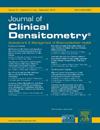Comparison of Body Composition Estimates in Hispanic Women by Dual-Energy X-ray Absorptiometry and Hydrostatic Densitometry
IF 1.6
4区 医学
Q4 ENDOCRINOLOGY & METABOLISM
引用次数: 0
Abstract
Introduction: Accurate assessment of body composition is critical for understanding health risks and developing appropriate interventions, particularly in underrepresented populations. The purpose of this study was to compare the body composition estimate (% body fat [%BF]) between dual-energy x-ray absorptiometry (DXA) and hydrodensitometry via hydrostatic weighing (HW) in a group of Hispanic pre-menopausal women.
Methodology: Healthy Hispanic women (n=78, age: 22–51 years, BMI: 18.5–42.5) were measured for body composition by DXA and HW at a single lab visit. %BF from HW was calculated from body density using three commonly used adult-specific equations (2-component [2-C] Siri, 2-C Brozek, 3-component [3-C] Lohman) and a 2-C Hispanic-specific equation. Comparisons between the two methods (DXA and HW) were analyzed using paired t-tests, and linear regression and Bland-Altman plots were used to assess agreement between the two methods.
Results: %BF was significantly higher by DXA compared to all four HW equations (P < 0.01). Based on regression analyses the mean difference scores were not different from zero for all estimates of %BF.
Conclusions: While DXA and HW are both common laboratory measures for determining %BF, given the time-efficiency, minimal participant effort, and high precision, %BF estimation by DXA appears to be an adequate and sufficient method of measurement of body composition in Hispanic women.
用双能x线吸收仪和静压密度仪估算西班牙裔妇女身体成分的比较
引言:准确评估身体成分对于了解健康风险和制定适当的干预措施至关重要,特别是在代表性不足的人群中。本研究的目的是比较一组西班牙裔绝经前妇女双能x线吸收仪(DXA)和液体静力称重(HW)的体成分估计值(体脂% [%BF])。方法:健康的西班牙裔女性(n=78,年龄:22-51岁,BMI: 18.5-42.5)在单次实验室访问时通过DXA和HW测量身体成分。根据体密度,采用三种常用的成人特异性方程(2组分[2-C] Siri, 2组分[2-C] Brozek, 3组分[3-C] Lohman)和2组分[3-C]西班牙裔特异性方程计算BF %。使用配对t检验分析两种方法(DXA和HW)之间的比较,并使用线性回归和Bland-Altman图来评估两种方法之间的一致性。结果:与所有四种HW方程相比,DXA显著提高了BF % (P <;0.01)。基于回归分析,对于所有%BF的估计,平均差异分数与零没有差异。结论:虽然DXA和HW都是确定%BF的常用实验室测量方法,但考虑到时间效率、最小的参与者努力和高精度,DXA估计%BF似乎是西班牙裔女性身体成分测量的适当和充分的方法。
本文章由计算机程序翻译,如有差异,请以英文原文为准。
求助全文
约1分钟内获得全文
求助全文
来源期刊

Journal of Clinical Densitometry
医学-内分泌学与代谢
CiteScore
4.90
自引率
8.00%
发文量
92
审稿时长
90 days
期刊介绍:
The Journal is committed to serving ISCD''s mission - the education of heterogenous physician specialties and technologists who are involved in the clinical assessment of skeletal health. The focus of JCD is bone mass measurement, including epidemiology of bone mass, how drugs and diseases alter bone mass, new techniques and quality assurance in bone mass imaging technologies, and bone mass health/economics.
Combining high quality research and review articles with sound, practice-oriented advice, JCD meets the diverse diagnostic and management needs of radiologists, endocrinologists, nephrologists, rheumatologists, gynecologists, family physicians, internists, and technologists whose patients require diagnostic clinical densitometry for therapeutic management.
 求助内容:
求助内容: 应助结果提醒方式:
应助结果提醒方式:


